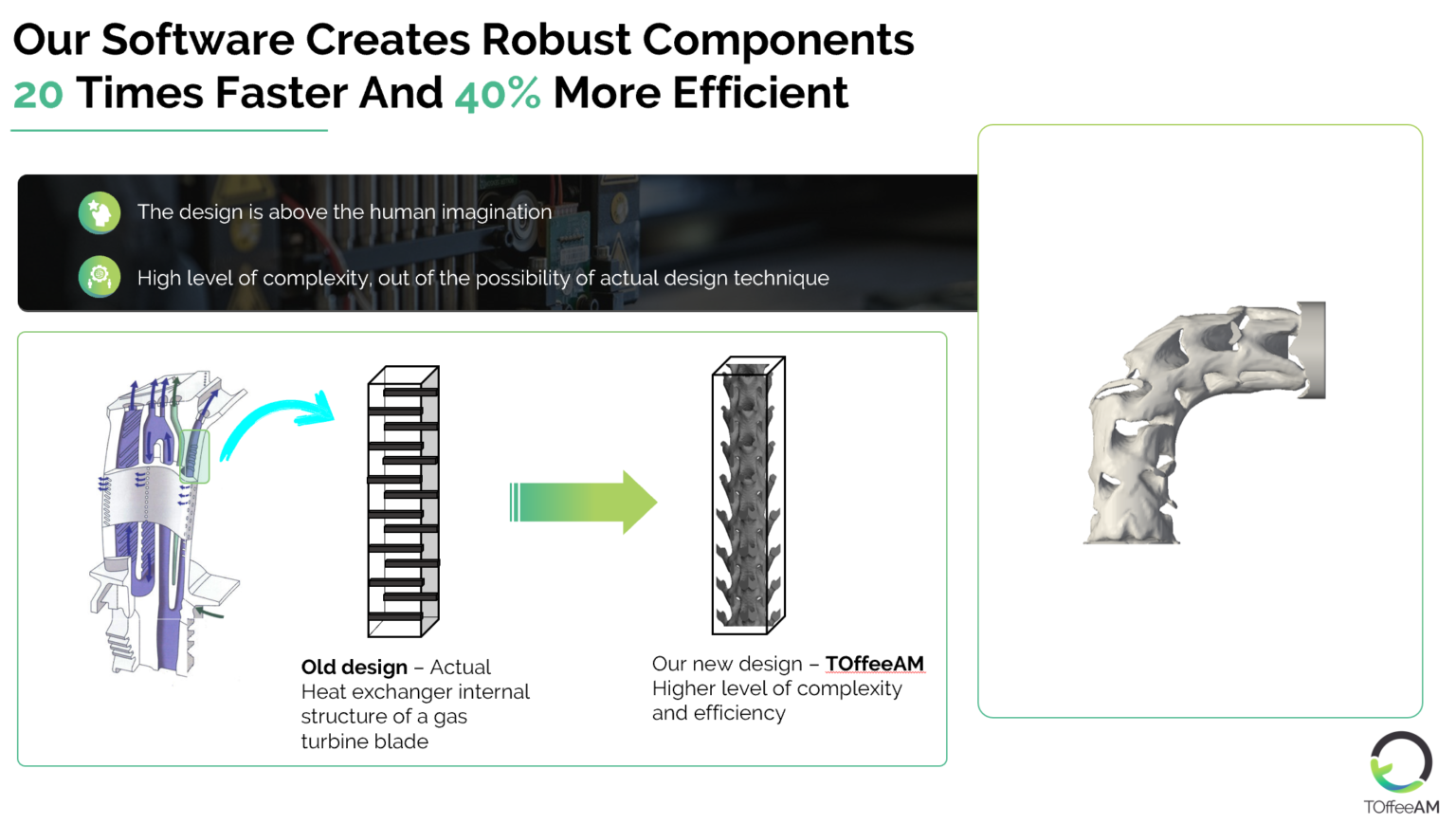TOffeeAM raises £1 million for AI Topology Optimization Tool for 3D Printing
TOffeeAM, launched from Imperial College’s Techcelerate program, recently secured £1 million in seed funding. The funding was primarily led by IQ Capital, together with Entrepreneur First, the Royal Academy of Engineering and the Techcelerate program.
TOffeeAM’s Design-for-Additive-Manufacture (DfAM) solution, which optimizes industrial product designs and structures using AM to improve performance, is of particular use to the aerospace and automotive industries. Last year, the London-based company had already secured business with GE Aviation, and clients such as Baker Hughes and a Formula 1 motor racing team. With the newly-won funding, the company will now look to further commercialize the technology, and expand its existing capabilities, recruitment, and customer base.
The company had been founded by Dr. Marco Pietropaoli (COO) in 2019, with support from the Techcelerate program for the software solution developed together with Dr. Montomoli (CEO) and Dr. Gaymann (CTO) at the Department of Aeronautics at Imperial. Their software, TOffee, uses artificial intelligence and state-of-the-art mathematical models to design and improve complex, intricate, mechanical components for heat or fluid transfer for use in the aerospace, automotive, and energy industries.
Its smart industrial production software delivers a ‘robust optimization’ that are less affected by errors in design data or manufacture due to the solution’s improved Uncertainty Quantification. The validated software code which can be licensed, allows for an intricacy and complexity of design not possible using standard design processes, and allows for part consolidation with increased component resilience, resulting in components 40% more efficient, produced 20 times faster than those of competitors.
Heat exchangers are key components in improving the efficiency and performance of aircraft or car engines, and gas turbines, and in other heating/cooling regulatory systems across industries. Conventional manufacturing techniques have been limited in their ability to further improve heat exchanger design or performance, and are more costly, time-consuming, and inefficient for prototyping or manufacturing compared to AM.
3D printing enables far more complex and intricate designs to improve heat exchanger capabilities, efficiency, and performance. It also enables simplification (and miniaturization) of parts and production, while reducing weight and increasing compactness to provide far greater performance and quality than conventional heat exchangers. Today, 3D Printing is the only technology capable of manufacturing next-generation of heat exchanger designs, and the latest 3D printed thermal engineering solutions from companies such as Conflux Technology, and GE Research are truly reinventing heat or fluid exchanger technology. The solution has won several awards, including the Royal Academy of Engineering Enterprise Fellowship, Techcelerate prize, the Amazon AWS Programmable 2018, and the Amelia Earhart Fellowship. You can watch their pitch at the Entreprenuer First Europe 12 Demo below.
Video courtesy of Entrepreuer First
From inception to launch to this recent seed funding round for €1.1 million, TOffeeAM received support not only from Techcelerate, but also from the Imperial Venture Mentoring Service (part of the Enterprise Team), the Royal Academy of Engineering (provided £60,000 in funding), and Entrepreneur First (provided £80,000 in funding).
Subscribe to Our Email Newsletter
Stay up-to-date on all the latest news from the 3D printing industry and receive information and offers from third party vendors.
Print Services
You May Also Like
3D Printing Grows to $15.9B in 2024 Amid Shifting Industry Dynamics
The global additive manufacturing (AM) market reached $15.9 billion in calendar year 2024, according to “Q4 2024 3DP/AM Market Data and Forecast” from Additive Manufacturing Research (AM Research). Despite a...
Low-cost “Suzy” Polymer Powder 3D Printer is Faster and Cheaper than Past Models
Polish laser powder bed fusion (LPBF) firm Sinterit has released a follow-up to its predecessors, Lisa and Nils, called Suzy, a $19,490 printer equipped with a 30W fiber diode laser....
BellaSeno’s 3D Printed Breast Implants Keep Shape with 87% Fat Volume, Avoids Silicone Risks
At a medical conference in Austin this week, a new kind of breast implant took center stage. It is not made from silicone but from a 3D printed, fully resorbable...
Australia’s Untapped Potential as a Disruptive Innovator: SPEE3D CTO Steven Camilleri Explains Why He Wants to Make Stuff There
When I first met Steven Camilleri in 2023, the CTO of additive manufacturing (AM) OEM SPEE3D shared a quote with me from Clayton Christensen, the late Harvard professor who popularized...



























